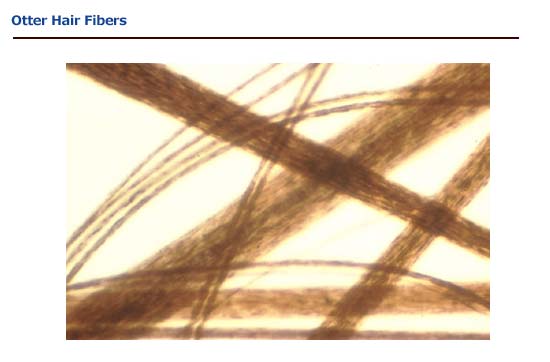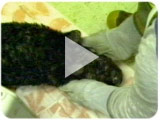Sea otters typically live in water temperatures that are 21-38°C (70-100°F) below their core body temperature. Because of this large thermal gradient and the high heat conductivity of water, which is more than twenty-five times that of air, sea otters need good thermal insulation to prevent rapid and excessive heat loss. Unlike cetaceans and most species of pinnipeds, sea otters lack a subcutaneous layer of blubber and depend on air trapped within their dense fur for insulation. The amount of air trapped between the hairs is related to both hair length and to the number of hairs per unit area (hair density) (Tregear, 1965). Most of the heat loss through the pelt is due to conductive and convective heat transfer from the air layer in the fur to the ambient air or water at the tips of the hairs.

Sea otter fur is the densest of any mammal and is composed of stout overhairs (guard hairs) and shorter, finer underhairs (Tarasoff, 1974). Hair density ranges from 26,413 to 164,662 per cm2, with highest densities on the forearms (164,662), sides (157,264), rump (118,691), stomach (82,251), and back (77,526) (Williams et al., 1992). The lowest densities are found on the chest (34,639), legs (30,761), and feet (26,413). Each hair bundle contains one guard hair and a variable number of underhairs (range = 12 underhairs per bundle on the legs to 108 underhairs per bundle in the midlateral areas). The length of the guardhairs (2.6-31.5 mm) and underhairs (1.5-26.3 mm) also varies with location on the body, with the shortest hairs on the legs and feet. The guard hairs are oval to round in cross section and have a diameter that ranges from 44-106 microns (mean diameter = 70 microns) (Williams et al., 1992). Underhairs, which are irregularly shaped due to cuticular scales, are wavy and have a mean diameter of 10.3 microns. Sea otters appear to replace their hair throughout the year and do not have a seasonal molt.
The structure of sea otter skin and hair follicles is similar to that described for other carnivores (Williams et al., 1992). The epidermis is thin and consists of only one or two cell layers and the keratinized stratum corneum. The dermis is 2.25-3.25 mm thick and is composed of collagenous connective tissue, smooth muscle, blood vessels, nerves, and apopilosebaceous complexes. The hair follicle is essentially a turbular invagination of the epidermis which encloses a small spike of dermis at its base (Ebling and Hale, 1983). Noticeably absent are arrector pili muscles. Each follicle has a thin, tubular shaped sebaceous gland and an apocrine sweat gland (Williams et al., 1992). The sebum of sea otters is primarily squalene (Davis et al., 1988; Williams al., 1992). The apocrine gland secretions mix with sebum at the skin surface and are distributed over the fur by the otter’s grooming behavior. The total lipid content of the fur ranges from 7.4-27.7 mg/g fur (Williams et al., 1988; Williams et al., 1992). The sebum keeps the skin soft and pliable and may contribute to the fur’s water repellency.
Each hair is composed of a cortex, an outer cuticle, and a central medulla. The main structural component of hair is hard, alpha-keratin, which consists of microfibrils embedded in a nonfilamentous matrix (Gillespie, 1983). Most of the keratin occurs in spindle-shaped cells located in the cortex. The cortex is covered by a cuticle of sheet-like cells that overlay each other from the root to the tip of the hair. The medulla consists of air-filled cells located in the center of the cortex. Guard hairs are typically medullated, but underhairs are medullated only at their base.
The cuticle of sea otter hair is of special interest in relation to felting and the entrapment of air (Swift, 1977). The cuticular cells create a scaly, ratchet-like surface on the hair and give it a differential coefficient of friction according to whether the impinging surface moves along the fiber from root to tip (i.e. in the direction of the overlapping scales) or from tip to root (i.e. against the direction of the scales). The differential friction effect causes individual fibers within the mat to move preferentially in one direction, thereby becoming locked within the fiber mat. When sea otters groom themselves, they vigorously rub their fur with their forepaws and hind flippers. This activity is essential for maintaining the interlocking underhairs. The amount of air trapped within the felt-like mat is enhanced by the waviness and density of the underhair. The interstices (i.e. intervening spaces) between the hairs are small, yet the void space is still large (i.e. over 80% of the pelt volume). The small interstices and hydrophobic surface of the cuticle prevent the penetration of water (because of the liquid surface tension) and allow air to be trapped between the hairs.
When sea otters encounter an oil spill, the oil penetrates their fur, disrupts the interlocking arrangement of the underhairs, and displaces the air layer (Figure 6.1). The hydrophobic surface of the cuticle and the large surface area of the fur trap the oil and make it impossible for the otter to clean itself. As a result, the oily, clumped fur loses most of its insulation, and the otter is subject to lethal hypothermia.



